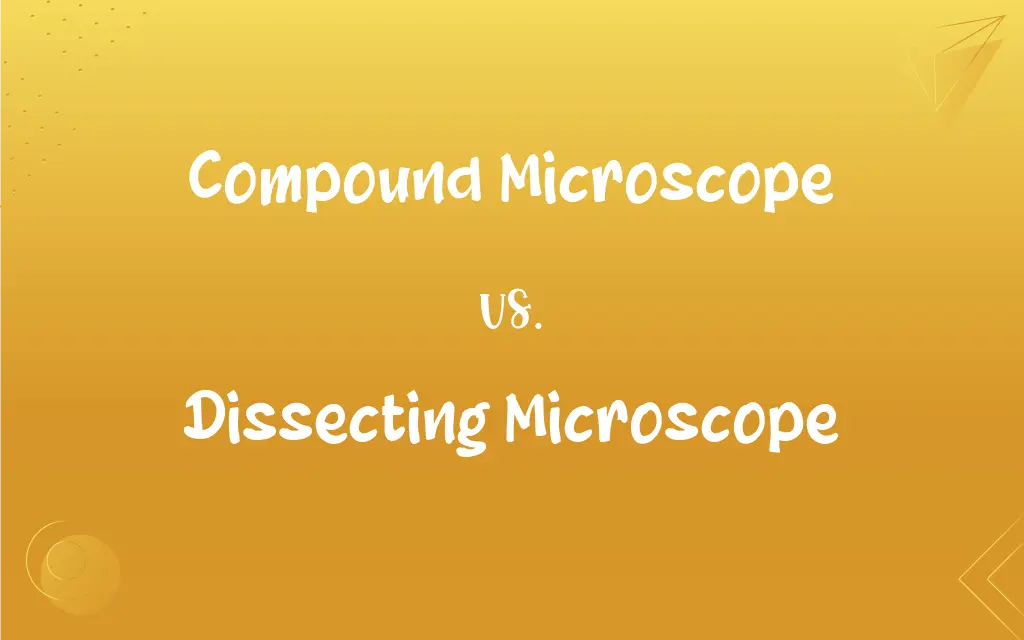Compound Microscope vs. Dissecting Microscope: What's the Difference?
Edited by Aimie Carlson || By Harlon Moss || Updated on June 10, 2024
A compound microscope magnifies using multiple lenses for detailed cellular study, while a dissecting microscope provides lower magnification for observing larger, more macro specimens.

Key Differences
A Compound Microscope utilizes multiple optical lenses, usually two: the objective and the eyepiece. This setup allows for high magnification, making it ideal for viewing tiny organisms or cell structures. On the contrary, a Dissecting Microscope, often known as a stereo microscope, typically offers lower magnification but a larger field of view.
In biology laboratories, a Compound Microscope is the instrument of choice when the intent is to study the detailed internal structures of cells or microbes. Meanwhile, a Dissecting Microscope is better suited for tasks that don't require as much magnification, such as examining insect anatomy or plant parts.
While both instruments offer a glimpse into the smaller details of our world, the Compound Microscope provides a deeper dive, enabling users to observe things like bacteria or blood cells. The Dissecting Microscope, however, allows for a three-dimensional observation of an object, making it perfect for dissections or studying surface details.
One could imagine using a Compound Microscope in scenarios that demand a closer look into the cellular and molecular realm. On the other hand, a Dissecting Microscope would be the tool of preference when working with larger specimens that require manipulation under magnification, such as the dissection of a frog or the examination of a circuit board.
Comparison Chart
Magnification
High magnification (up to 1000x or more)
Lower magnification (usually up to 100x)
ADVERTISEMENT
Optical System
Uses multiple lenses
Typically has two separate optical paths
View
Two-dimensional
Three-dimensional
Usage
Cellular and molecular study
Examination of larger specimens
Field of View
Narrower
Broader
Compound Microscope and Dissecting Microscope Definitions
Compound Microscope
Allows visualization of microscopic organisms or details.
Bacteria that were invisible to the naked eye were seen with the Compound Microscope.
ADVERTISEMENT
Dissecting Microscope
Often known as stereo microscope due to its three-dimensional view.
The gemologist preferred the Dissecting Microscope for examining gems' surfaces.
Compound Microscope
An optical instrument using multiple lenses for high magnification.
The biology student viewed the cell division using a Compound Microscope.
Dissecting Microscope
An instrument providing a broader field of view than high-magnification counterparts.
The circuit board details were easily accessible under the Dissecting Microscope.
Compound Microscope
Microscope designed for observing minute details.
Cellular structures became visible under the Compound Microscope.
Dissecting Microscope
Microscope designed for viewing larger specimens in 3D.
The student used a Dissecting Microscope to study the insect's anatomy.
Compound Microscope
Used primarily in labs for cellular studies.
The scientist spent hours at the Compound Microscope studying the samples.
Dissecting Microscope
Suitable for tasks like dissections or surface studies.
During the frog dissection, the Dissecting Microscope proved invaluable.
Compound Microscope
An instrument with two sets of lenses: objective and eyepiece.
She adjusted the objective lens on the Compound Microscope for a clearer view.
Dissecting Microscope
Provides lower magnification but enhanced depth perception.
For botany studies, the Dissecting Microscope made observing leaf structures simpler.
FAQs
Is a Compound Microscope suitable for viewing bacteria?
Absolutely, a Compound Microscope is ideal for viewing bacteria and similar microorganisms.
Are the images from a Compound Microscope two-dimensional?
Yes, Compound Microscopes provide a two-dimensional view.
Can a Dissecting Microscope give a three-dimensional view?
Yes, a Dissecting Microscope provides a three-dimensional view of specimens.
Does a Compound Microscope offer higher magnification than a Dissecting Microscope?
Yes, a Compound Microscope typically offers much higher magnification.
Would you use a Dissecting Microscope for detailed cellular studies?
No, for detailed cellular studies, a Compound Microscope is more appropriate.
Is depth perception better in a Dissecting Microscope?
Yes, a Dissecting Microscope offers enhanced depth perception.
What’s the main advantage of a Dissecting Microscope over a Compound Microscope for larger specimens?
The main advantage is the broader field of view and the ability to observe in three dimensions.
What kind of microscope offers a broader field of view?
A Dissecting Microscope offers a broader field of view.
Are both microscopes used in standard biology labs?
Yes, both Compound Microscopes and Dissecting Microscopes find use in biology labs depending on the task.
For gemology, which microscope is preferable?
A Dissecting Microscope is typically preferred in gemology for its 3D view.
Which microscope would you use to study blood samples?
Blood samples are best studied under a Compound Microscope for detailed cellular observation.
Can you view viruses using a Compound Microscope?
Viruses are smaller than bacteria and often require electron microscopes for visualization, not typically a Compound Microscope.
Can a Compound Microscope connect to a computer?
Some modern Compound Microscopes come with digital capabilities to connect to computers.
Can I observe live insects using a Compound Microscope?
It's more suitable to use a Dissecting Microscope for observing live insects due to its broader view and space.
Is it easier to manipulate specimens under a Dissecting Microscope?
Yes, a Dissecting Microscope provides more space and is designed for specimen manipulation.
Which microscope is also known as a stereo microscope?
The Dissecting Microscope is often referred to as a stereo microscope.
Can you study plant cells with a Compound Microscope?
Yes, plant cells can be observed in detail with a Compound Microscope.
Can you adjust magnification in a Compound Microscope?
Yes, you can adjust magnification in a Compound Microscope by changing the objective lenses.
Are there digital versions of a Dissecting Microscope?
Yes, there are digital Dissecting Microscopes that can connect to computers or screens.
For observing the surface of coins, which microscope is apt?
A Dissecting Microscope is apt for observing the surface details of coins.
About Author
Written by
Harlon MossHarlon is a seasoned quality moderator and accomplished content writer for Difference Wiki. An alumnus of the prestigious University of California, he earned his degree in Computer Science. Leveraging his academic background, Harlon brings a meticulous and informed perspective to his work, ensuring content accuracy and excellence.
Edited by
Aimie CarlsonAimie Carlson, holding a master's degree in English literature, is a fervent English language enthusiast. She lends her writing talents to Difference Wiki, a prominent website that specializes in comparisons, offering readers insightful analyses that both captivate and inform.































































